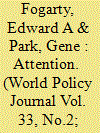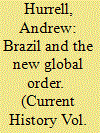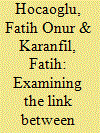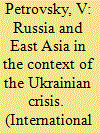| Srl | Item |
| 1 |
ID:
145617


|
|
|
|
|
| Summary/Abstract |
Political scientists Edward A. Fogarty and Gene Park argue that the world’s response to the 2008 economic crisis demonstrates that, when the next global economic disaster hits, members of the G-20 will work together. Outside of crisis, the G-20 can only be expected to take baby steps toward greater coordination and fiscal transparency.
|
|
|
|
|
|
|
|
|
|
|
|
|
|
|
|
| 2 |
ID:
093668


|
|
|
|
|
| Publication |
2010.
|
| Summary/Abstract |
Brazilian foreign policy under Lula has emphasized not only traditional multilateralism but also membership in the new formal and informal groupings that have emerged at the heart of a new world order.
|
|
|
|
|
|
|
|
|
|
|
|
|
|
|
|
| 3 |
ID:
105780


|
|
|
|
|
| Publication |
2011.
|
| Summary/Abstract |
In this paper, the relationship between per capita CO2 emissions and the share of industrial value added in gross domestic product (GDP) for the G-7 countries is discussed using a novel approach. It is assumed that per capita CO2 emissions are correspondent to the share of industrial value added in GDP. A model is developed using hidden Markov process to search this initial assumption. In the model, the data for industrial share in GDP are assigned to be the observations, while the data for per capita CO2 emissions represent the hidden process, which may be then predicted using the ratio of industrial value added to GDP. The data set covers the period from 1970 to 2008 and the model is tested for the G-7 countries. The study findings show that, except in the case of Canada, the hidden Markov model performs reasonably well in tracking per capita CO2 emissions. The study results provide also a basis for a number of policy implications.
|
|
|
|
|
|
|
|
|
|
|
|
|
|
|
|
| 4 |
ID:
138056


|
|
|
|
|
| Summary/Abstract |
THE SYSTEM of international relations and the world order are being "tested by Ukraine," the situation in which Russia's relations with East Asia are not an exception but a confirmation of the process and an illustration of it.The U.S. Administration resolved to isolate Russia from the rest of the world urged the EU, the rest of the continent and also the East Asian and APR countries to introduce anti-Russian sanctions. In July 2014, at the height of the scandal around the Malaysian "Boeing" shot down over Eastern Ukraine, Peter Harrell, Deputy Assistant Secretary for Counter Threat Finance and Sanctions, travelled far and wide across the region to persuade top officials and leaders of the business communities to side with the United States.
|
|
|
|
|
|
|
|
|
|
|
|
|
|
|
|